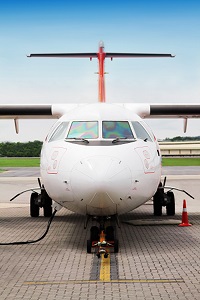Meeting the Catalysis Challenge in Aviation Fuels
by John Holladay

While aviation only accounts for about 2 percent of our energy use (9 percent of transportation), it has received much attention for its contributions to greenhouse gas—3 percent of global anthropogenic CO2 emissions and 2-14 percent of anthropogenic-induced warming from the co-emission of NOX, SO2, and black carbon and formation of aircraft vapor trails (Kapadia et al. 2013). Over the years, the aviation industry has made great strides in improving energy efficiency. Today's jet aircraft are greater than 70 percent more fuel-efficient than early jets of the 1960s, such as the Comet 4, and can average as high as 100 passenger miles per gallon (Peeters et al. 2005). To reduce greenhouse gases further, there are additional strides in efficiency to be made, but, at the same time, we are working with industry to provide alternative, low-carbon, renewable fuels that can be used in commercial aviation.
Recently, Washington State University was awarded a Federal Aviation Administration Center of Excellence being co-led with the Massachusetts Institute of Technology. This Center is set up for 10 years to consider environmental aspects—think fuel efficiency and other environmental concerns—and alternative fuels—think low-carbon alternatives to fossil-derived fuels. PNNL is partnering with WSU to make this work. And, PNNL's catalyst programs also have many other activities going on. The bottom line is a goal to develop low-cost approaches for producing middle distillate fuels that 1) meet strict requirements on fuel quality, 2) reduce greenhouse gases by 60 percent over petroleum fuels, 3) minimize the need for hydrogen, and 4) can be accomplished with reduced capital cost.
The challenge is how to selectively remove oxygen and reset carbon-carbon bonds to form the types of molecules needed in aviation fuel. Pyrolysis provides one platform. The nature of the thermal chemistry leads to cyclic phenolic-type intermediates. Catalytic fast pyrolysis produces aromatic-rich fuels, but these lead to soot formation in fuel afterburner emissions. Changing the feedstock provides one way to alter the product distribution, and hydrothermal liquefaction of algae-based biomass affords a way to capture both neutral (easily assessed) and non-neutral lipids. Catalysts play a role in upgrading these oils, which provide paraffin-rich fuels. The hydrogen demand for upgrading these intermediates is much lower than that required for pyrolysis oils. Alcohols, produced from biomass using fermentation or catalytic approaches, offer a third path. PNNL has developed catalytic technologies to make non-cyclic, paraffin-rich middle distillates that require very low hydrogen to produce the final fuel. By changing the conditions slightly, we also can produce cyclic materials.
All of this points to the need for improved catalysts that are stable in high water environments, are more active than many catalysts available today, and provide control of selectivity for cleaving carbon-oxygen bonds and forming new carbon-carbon bonds. For success, the interplay between the science base and applied programs is critical. This includes improving our understanding of reaction kinetics and developing robust theory to show how metal-metal interactions and metal-support interactions can be used for selective transformations. However, it also includes understanding how catalyst activity degrades during reactions that will allow design of new catalysts with improved lifetime. In turn, this points to how we can use the science base within the Institute for Integrated Catalysis for moving technologies out the door with our industrial partners that need robust and relevant solutions for producing fuels from alternative resources..
Dr. John Holladay is in the Energy and Environment Sector of Pacific Northwest National Laboratory, where he is responsible for the Laboratory's research portfolio of biofuels, products, and energy.
References
- Kapadia Z, D Borman, D Spracklen, S Arnold, G Mann, and P Williams. 2013. "Investigating the impacts of aviation NOX, SO2 and black carbon emissions on ozone, aerosol and climate." EGU General Assembly 2013, April, 7-12, 2013, Vienna, Austria, id. EGU2013-7086.
- Peeters P, J Middel, and A Hoolhorst. 2005. "Fuel efficiency of commercial aircraft, An overview of historical and future trends." National Lucht-en Ruimtevaartlaboratorium, NLR-CR-2005-669.

